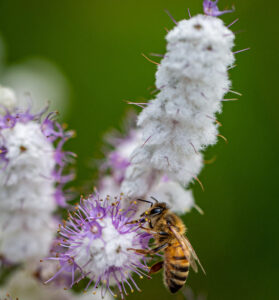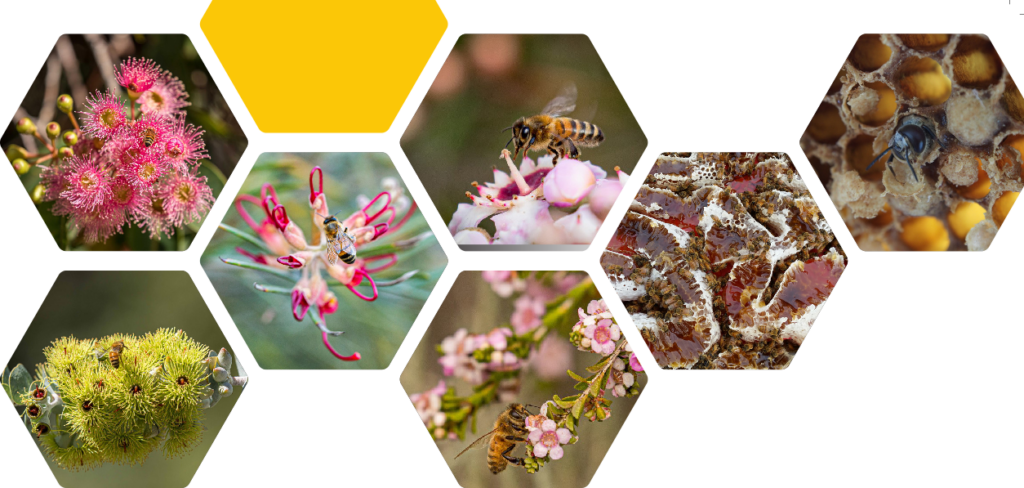When Dr Liz Barbour offers taste tests of West Australian honey, people are shocked at the range of flavours.
Each variety has its own distinct characteristics—from the smooth butterscotch finish of jarrah honey to the bitter aftertaste of peppermint honey.

Dr Barbour, who is the chief executive of the CRC for Honey Bee Products, says that’s because plant nectars all contain different flavonoids, phenolics and other compounds.
“The bee will take that nectar into the honey, and the chemical signature stays there,” she says.
Until now, beekeepers haven’t actually been able to confirm which plants their bees are feeding on.
But ICRAR, the CRC for Honey Bee Products and the bee industry are working to change that, with a project to identify the unique chemical signature of different honey varieties.
It’s a huge challenge, because bees typically feed on nectar from a mix of plants.
“We can’t control the bees,” Dr Barbour says. “So where they go depends on their needs and where the flowers are.
“They’ll go from one flower to another flower to another, so it can get to be quite a complicated signature.”
The CRC for Honey Bee Products supported a UWA PhD student—Md Khairul Islam—who, under supervision from Dr Connie Locher, started analysing different honeys using a “cheap and cheerful” technique called high-performance thin-layer chromatography.
They wanted to see if the bees were actually feeding on the plants the beekeepers believed they were.
But there was no reference point for what pure honey from a single species looks like.
Without knowing what they were looking for—and with West Australian bees feeding on about 250 different plants—it was near impossible for the researchers to tease out the signatures of the different nectars.
Drowning in statistics, Dr Barbour turned to an old office mate— ICRAR data intensive astronomer Kevin Vinsen.
“I said to Kevin ‘we need your help’… it’s like the Universe trying to sort it all out,” she says.
“Vinsen, a machine learning expert, immediately saw parallels between the honey profiles and star spectroscopy.”
“When you look at a star, it has a light curve, which shows you the intensity of the photons across different wavelengths,” he says.
“With the honey, what we’re seeing is the intensity of flavonoids and phenolics across a range. So the basic principle is fairly similar.”

Georgie Wilson and Tiffane Bates
In astronomy, a light curve might tell scientists they’re looking at a brightly-burning, young star.
In a similar way, the peaks and troughs of honey profiles could be used to identify the unique flavonoid signature of a particular honey variety.
Vinsen says the research is a classic “unsupervised learning” problem.
“We’re not taking any prior knowledge,” he says. “We’re just saying ‘what’s there, what groups together best among this’?”
Most of the honeys tested turned out to be a mix of several different nectars, with some nectars dominating.
“It’s been really important for us, because we’ve also been looking at the bioactivities of these same honeys,” Dr Barbour says.
“We’ve been working on what the beekeeper has been telling us, and we’ve been getting results all over the place.
“Now we can actually see why we’re getting these bioactivity variations, because of the variation in the nectars. So it’s been fascinating.”
The one exception was coastal peppermint honey. It seems bees that feed on coastal peppermint flowers don’t eat much else.
“That’s so unique, there’s something in that nectar that stands out like a sore thumb,” Vinsen says.
“We’ve got such a variety of brilliant honeys here,” Dr Barbour says.
“The jarrah is a very different honey… it doesn’t crystallise because it’s got high fructose and it’s very highly bioactive.
“The marri is quite different, it crystallises with its higher glucose and the pollen in it, but it’s still just as good.
“The coastal peppermint, that’s got a very high antioxidant activity.”
“The research could lead to a certification system to support a high-value export industry for WA honey.”
Dr Barbour’s team is currently working on a marketing project that aims to develop consistent terms for the flavours in honey—much like those used for wine.
The next step is to work out what percentage of a honey needs to come from a single species for it to maintain the characteristics expected of that honey.
If we are going to trade mark a name, then the amount of the nectar source within the product needs to be known.
And this is the battle New Zealand are presently pursuing, trying to show that their measurement of four individual substances relates to a dominance of Manuka nectar in their honey.
“Whereas New Zealand just has one iconic honey, we’ve got a whole lot of them,” Dr Barbour says. “So what we’re trying to do is separate them out.”